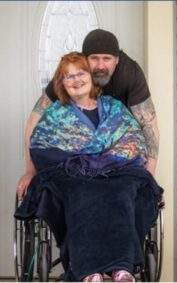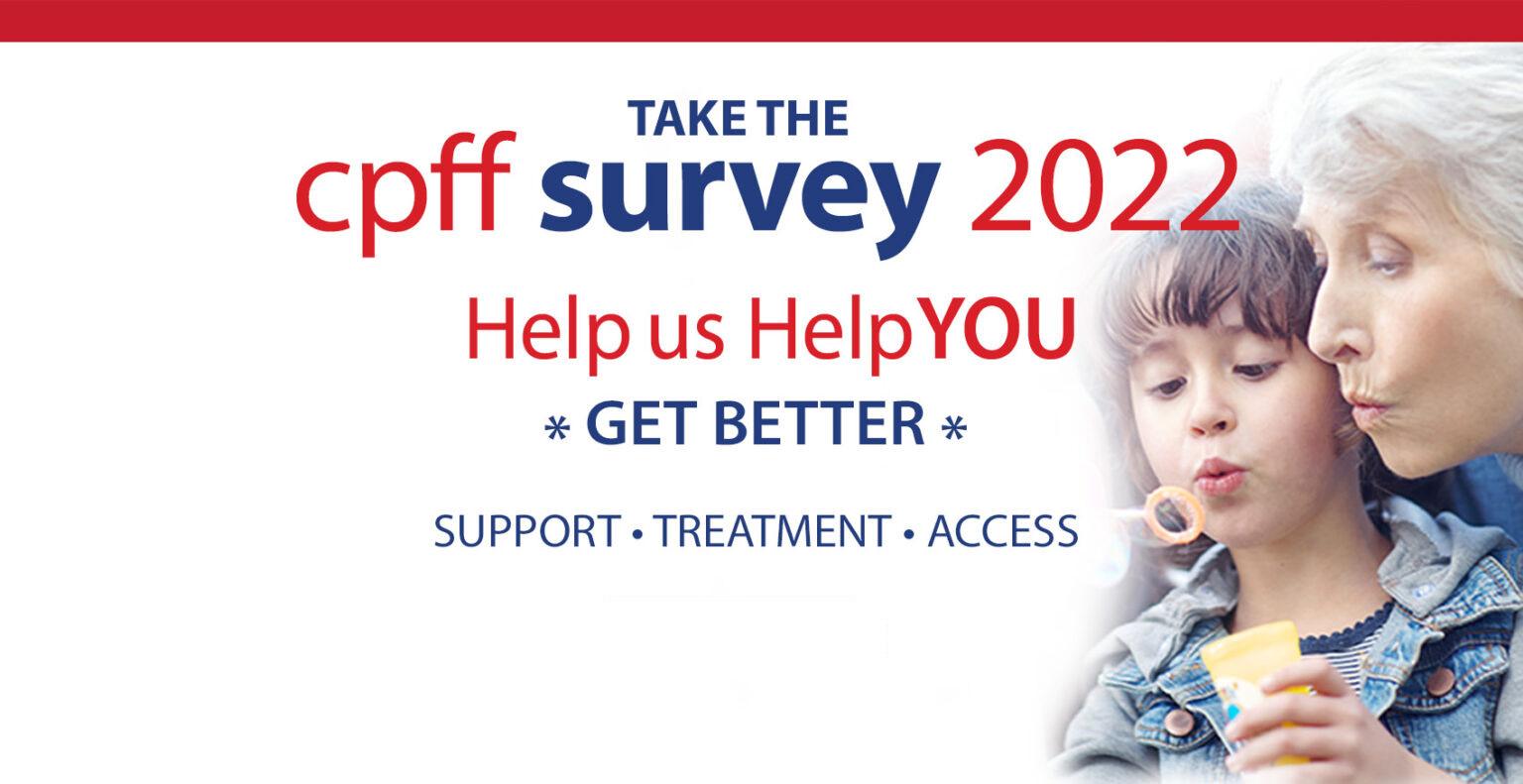Remember to complete the CPFF 2022 patient and caregiver survey
CPFF’s 2022 patient and caregiver survey is open for your responses until this Friday, June 10. Don’t miss this opportunity to share your experiences of living with pulmonary fibrosis so that we can create future plans that will help us to serve you better than ever. It takes about 15 minutes to complete the survey.
“The survey results will help your Foundation to focus on the research, activities, resources and advocacy initiatives that you want,” says Sharon Lee, CPFF’s Executive Director. “Your unique experiences will help inform how we advocate for better support, treatments, and access to care that will make a difference for you and your family.
“We hope to see more caregivers complete the survey this time,” says Lee, “as their voices, needs, and well-being are essential to the health of our Community in so many ways, and we want to know how best to help them cope and thrive.”
It’s been two years since the Canadian Pulmonary Fibrosis Foundation (CPFF) last asked you to tell us about your experiences living with PF. The survey results at that time were summarized in our Breathless for Change Report, which has guided much of our work since that time and provided focus and data for our advocacy campaigns.
While much of the intervening time has been spent addressing your support and information needs during the pandemic, CPFF has also continued to advocate for improved access to treatment and care, presented dozens of online educational videos and invested in our research programs, among many other initiatives.
In addition to the survey, CPFF will also be reaching out to health care professionals and oxygen providers that care for people with pulmonary fibrosis, to determine how we can help them better serve our Community, through education, advocacy and research funding.
Your privacy is important to us. The data collected from the survey may be shared with government agencies and other disease organizations. To ensure your privacy and confidentiality, individual responses will not be identifiable. Please note that selected quotations may be used publicly without reference to a respondent’s name or any other identifying information.
Editor’s note: Our apologies to those who tried to do the survey when it first launched last week. A technical glitch that lasted a couple of hours has been corrected and you should be able to complete the survey now.
Update from the CPFF Board Chair

Just thought I would let everyone know that the CPFF Board of Directors have been very active this spring. Our fiscal year ends on July 31, so to that end, we held a virtual, two-day Board retreat in early May where we developed priorities for next year. As well, at last week’s monthly Board meeting (again done virtually), we approved our annual budget.
Our balance sheet is in good shape, so we’ve decided to up our spending and investment in both the PF community and the organization. On top of continuing to fund new research fellowships and projects, we will complete updating our website as well as our communications systems and materials in order to better support our community and raise awareness about PF. In addition, we will enhance our activities and outreach during PF Awareness Month in September, all in the name of raising awareness about PF.
Advocacy will be a big focus in the upcoming year. In addition to continuing to work with governments on funding access to anti-fibrotic drugs, we have initiated a major study on oxygen accessibility across the country, and expect to complete it this year. We will identify best practices and then advocate for them with governments, with the goal of improving and harmonizing assessment, supply and funding.
Finally, we also expect to provide additional support and resources to the Patient Support Groups across the country. This will allow you to better connect and extend your reach within your individual communities.
As always, thanks to everyone for all you do for our PF community here in Canada. Remember, we are here for you, and so we always appreciate your feedback on activities, priorities and focus.
Take care and have a great summer!
Kirk Morrison
Board Chair, CPFF
Gearing up for Pulmonary Fibrosis Awareness Month

Now is the time to plan, organize and start promoting events and activities for September, national Pulmonary Fibrosis Awareness Month. We’ve got lots in store for you, including another outstanding series of educational webinars, as well as a brand new, do-it-yourself fundraiser kit with everything you need to create your own, local, walk, or other fundraising event.
“The Canadian Pulmonary Fibrosis Foundation has been blessed with the most passionate, dedicated group of supporters, ever,” says Sharon Lee, CPFF’s Executive Director. “Whatever the challenge, CPFF supporters rise to the occasion to increase awareness and hope and raise funds for people living with PF.”
John Dennis gets us started with a Ride in PEI
First off the block, with an early kick-off event is John Dennis, a man who loves a mission. The 77-year-old resident of Halifax received a lung transplant in 2021 after living with pulmonary fibrosis (PF) for five years. Last summer, just months after his surgery, he cycled various trails around Nova Scotia to raise awareness and funds for the Canadian Pulmonary Fibrosis Foundation (CPFF).
You can read more about John’s upcoming mission and his personal journey with PF and lung transplantation.
On June 10, 2022, at 10 a.m., John will launch his 700 km ride on his electric bike around PEI’s The Island Walk, with a send-off media conference at Joseph A. Ghiz Memorial Park, in Charlottetown, PEI. Calling his campaign “I Ride for You & Me,” John will raise awareness, hope and funds as he rides around the province. He hopes to ride 50 to 75 km per day, completing his journey in 11 or twelve days.
During his PEI journey John will also spread the message about the life-saving gift of organ donation, and advocating for other provinces to follow the lead of Nova Scotia in passing Implied Consent legislation, which helps increase the donation of critically needed organs.
Finally, John hopes to raise enough money to establish a CPFF research fund in memory of his late brother Brian Dennis, who died of pulmonary fibrosis, and in memory of Barbara Ann Barr Haylock, who also lived with PF, received a lung transplant and was a fervent patient advocate.
We’ve got everything you need for your own event
Each summer, individuals, families, employers, local companies and neighbourhoods, ask how they can help during our Awareness Month campaign. Now we have an easy way for them to get involved with our DIY fundraiser kit.
“With this handy fundraising kit, we hope to inspire and empower YOU to create your very own DIY fundraiser,” says Lee.
Ready to launch in the coming weeks, a step-by-step guide has everything you need to plan, set up a web page, and then promote your event. There are social media posts and images, a media outreach message, as well as a poster you can customize, to invite others to join you at your event.
Three walks are already scheduled:
Once again, the Clarke family will hold its walk for pulmonary fibrosis at Edworthy Park, 5050 Spruce Drive in Calgary on Saturday, September 10 from 10 a.m. to 5 p.m.
The Robert Davidson walk will take place at Toogood Pond in Markham, Ontario, on Sunday, September 11 from 10 a.m. to 1 p.m.
The CPFF Hope Breathes Here Walk in Montreal will take place on Saturday, September 17 from 10 a.m. to 1 p.m. in Angrignon Park.
All of your events will appear on the Hope Breathes Here website and we’ll help promote them on the CPFF social media outlets.
Start thinking about your event now. In the coming weeks, you’ll receive an email with the fundraising kit and guide. Because of you, hope breathes here!
Don’t forget to light up landmarks and proclaim Awareness Month
As always, we encourage individuals to make formal requests to their cities, towns and communities, to light up local landmarks (like sporting venues, town signs, clock towers, etc.) in red and blue to shine a light on pulmonary fibrosis.
June is also the right time to ask your local council or mayor, or your provincial premier or health minister to proclaim September as Pulmonary Fibrosis Awareness Month. You can find sample request letters and proclamations from last year on our website.
Please send an email to [email protected] to let CPFF staff know that you have made such a request, along with a copy of the request for a landmark lighting or proclamation. This will help prevent duplicate requests from multiple residents.
Stay tuned
While we do not publish this newsletter in July, we’ll send you any updates on Awareness Month via our social media outlets. And our August issue will have more details on upcoming educational webinars and so much more.
Study fills in some gaps on lung disease and rheumatoid arthritis

Using health services data between 2000 and 2018 from the province of Ontario, respirologist Dr. Lee Fidler and his co-principal investigator scientist Dr. Andrea Gershon of ICES, along with other colleagues, set out to investigate the incidence and prevalence of rheumatoid arthritis related interstitial lung disease (RA-ILD) in the province. The research was conducted at ICES and funded by a $20,000 research grant from CPFF.
Rheumatoid arthritis (RA) is the most common autoimmune disease affecting the skeletal system. Although it is widely recognized for its impact on the joints, RA can also result in some patients developing RA-ILD. The development of RA-ILD negatively impacts survival, with a two to three times higher mortality in patients with ILD compared to those without.
“In 2018, about 145,000 people in Ontario were living with RA,” says Dr. Fidler, “but we did not know how many of them developed RA-ILD, its impact on these patients or its subsequent impact on the health care system.” This study sheds some light on this knowledge gap.
The researchers found the number of new and total cases of RA-ILD to be increasing over time. The overall rate of RA-ILD cases increased roughly four times between 2000 and 2018. RA-ILD rates appear to be increasing in men, women, and RA patients of all ages. Men and patients over 70 years of age had the highest rates of RA-ILD.
Approximately 1 in 4 patients with RA-ILD who died between 2000 and 2018 had RA-ILD listed as a contributing cause of death. Despite this, RA-ILD related mortality appeared to decrease in the province by a third between 2000 and 2018. The reasons for the declining rates in mortality are unclear, says Dr. Fidler, but may suggest the increased availability and use of immunomodulatory and biologic treatments (such as monoclonal antibody infusions) in recent years has been effective in RA-ILD treatment.
“We hope that the results so far, encourage those treating people with RA to be alert to the possible development of ILD in their patients,” says Dr. Fidler.
For researchers, many questions remain. What has led to the decline in mortality in the past 20 years? Could it be the more aggressive treatment of RA and RA-ILD? If so, can we pinpoint a specific treatment or drug that is making the difference? Will the use of anti-fibrotics, recently approved for use in RA-ILD patients, have a positive impact on mortality? What is the impact on the use of the health care system? And are these results for Ontario, similar in other provinces? And more. Dr. Fidler and his team hope to explore some of these questions going forward.
“We are pleased with what we’ve been able to determine from this study, says Dr. Fidler. “And we are very grateful to CPFF and its donors for funding it.”
Dr. Fidler and Dr. Gershon published their study “Rheumatoid arthritis associated interstitial lung disease: Trends in epidemiology and mortality in Ontario from 2000 to 2018,” in the journal Respiratory Medicine, May 2023.
Webinar offers insights into genetics and PF

Most of us are familiar with the double-helix structure of DNA that resembles a curved ladder. But did you know that there 3 billion chemical base pairs in human DNA? Any idea how many of those genes may be involved in pulmonary fibrosis(PF)? And why do some individual’s PF progress much faster than others?
In a May 9 webinar from the EU-IPPF, called The Genetics of Pulmonary Fibrosis, Dr. Richard Allen of the University of Leicester, in the U.K., leads his audience through an introduction to genetics and how genetic variations can lead to disease. He also discusses the genetic changes associated with IPF and other forms of PF and explores the implications for new treatments and for familial pulmonary fibrosis patients.
After a brief overview of pulmonary fibrosis, he moves on to define DNA as a set of instructions that make us who we are. We each have two copies of DNA, one from our mother and the other from our father. The vast majority of these are the same. When there are differences between the two, these are called genetic variations.
Genes deliver instructions to make a protein, the building blocks of our bodies. And genetics is the study of genes and DNA. Genes are also identified using four letters: A,C,T and G.
When studying the genetics of pulmonary fibrosis, researchers investigate the genetic variations between a large number of people with PF and a large number of people without PF (the control group).
Dr. Allen explains all of this in layman’s terms with the aid of excellent diagrams. He sites an example of one gene in the “MUC5B position” on the DNA which helps produce mucus in the airways. Increased mucus may impair how the lungs defend or repair themselves.
If you have a “T” instead of a “G” in this position, your risk of developing IPF increases by five times. It is worth noting that in European populations, one in five people have at least one “T.”
“That doesn’t mean that everyone who has a T in this position will get IPF,” Dr. Allen points out. “If that were the case, IPF would be much more prevalent. It means that your risk is higher, if this gene, in combination with others, or with certain environmental exposures, may mean you will develop PF.”
Of course, this is only one example of a genetic variant that may contribute to PF. In genetic studies, we look at millions of variants, across the whole DNA, and test each one to see if it is associated with PF, says Dr. Allen. These are called genome-wide association studies or GWAS.
This is done by programming data analysis using a supercomputer. Dr. Allen and his team have access, even remotely, to such a resource at the University of Leicester, they call “Alice.” “While we often think of researchers working in white coats with microscopes, this genetic work involves intense computer analysis of huge data bases.”
Why do researchers work to identify genetic variants associated to PF? “If we can identify the variants involved in related biological processes, we can develop treatments to target these processes,” says Dr. Allen. “And if we can identify other conditions with a similar genetic make-up that already have treatments, we can investigate re-purposing medications used to treat those other conditions for PF.
Dr. Allen also mentioned that researchers may identify certain subsets of patients that have a specific genetic make-up and then we can target treatments that work best for each individual depending on their genetic make-up and which biological processes are involved in their disease. This is often referred to as “personalized medicine.”
In a recent study, involving five GWAS in the UK, the US, and Spain, 7.5 million genetic variants associated with IPF were identified analyzing data from 4,125 people with IPF and 20,464 people without it. When plotted on a graph, peaks show specific variant positions that are identified as having some role in IPF. One of the peaks is the one labelled as MUC5B – described earlier.
Researchers then look at what those genes do. They tend to fall into certain categories, such as lung defense, how cells stick together, cell replication, biological aging and fibrotic signalling. This last category involves the signal to repair damaged cells with scar tissue and another signal which stops the scarring action.
Two of the variants identified affect this cell repair and scarring activity. One variant AKAP13, keeps on laying down scar tissue after the repair. The other variant DEPTOR, fails to signal the body to stop the scarring action. Both contribute to a build up of scar tissue in the lungs. “These two variants are being investigated as targets for drug treatments.”
These are not the only variants involved in the risk of developing of IPF, states Dr. Allen, there are so many more. And not everyone who has these variants will develop the disease.
Other work in the field of genetics and PF, involves the rate of the progression of the disease, which is different for each individual. Another interesting point is that the genetics involved in disease risk for PF are quite different than those involved in disease progression, says Dr. Allen. And, disease progression is the area most effective in drug development.
A genetic variant involving the gene PKN2 has been identified as being involved in decreased lung capacity. What is exciting is that this gene is also being targeted in cancer studies. “This highlights that a drug targeted to this gene, although for another condition, could potentially be used to treat the progression of pulmonary fibrosis,” says Dr. Allen.
In summary, Dr. Allen reminds his audience that just having genetic variants associated with PF, does not mean you will get the disease, nor will your children or grandchildren get the disease. Most importantly, genetic research of pulmonary fibrosis is ongoing and gives us all hope of new and more effective treatments coming in the future.
New clinical practice guideline for pulmonary fibrosis

The American Journal of Respiratory and Critical Care Medicine recently published an updated idiopathic pulmonary fibrosis (IPF) clinical practice guideline, which also addresses the progression of pulmonary fibrosis in patients with interstitial lung disease (ILD) other than IPF.
The new guideline was created through a collaboration between the following respiratory institutions: The American Thoracic Society, European Respiratory Society, Japanese Respiratory Society, and Asociación Latinoamericana de Tórax. (Please note that in the document, the term “PPF” is used instead of “PF-ILD,” which is commonly used in Canada.)
Clinical practice guidelines are systematically developed and updated, evidence-based or consensus-based statements whose purpose is to help improve the quality and consistency of care in specified clinical situations. They are designed to “guide” health care professionals in their delivery of care and provide a basis for rational, informed decisions by clinicians.
You may want to share the link to the guideline with your family physician, your respirologist, or other health care professionals on your care team.
Jacqui Bowick-Sandor faced life post-transplant with amazing grace

It is with great sadness that the Canadian Pulmonary Fibrosis Foundation (CPFF) learned that Jacqui Bowick-Sandor of Smith Falls, Ontario, passed away on May 19, 2022, just three days before her 57th birthday.
After her diagnosis of IPF in 2012, Jacqui felt fortunate to meet up with CPFF Founder Robert Davidson and his wife Heather at an advocacy event at Queen’s Park, Ontario’s legislature.
In a 2020 profile of Jacqui in this publication, she said: “It was just so wonderful to speak to others who were facing the same challenges that I was. I got more involved in CPFF and attended several advocacy events and did some fundraising too.”
“She was quite amazing, always cheerful and supporting others, including many charities,” writes Heather Davidson. “She will be greatly missed. She always reminded me of Robert, they were both living the motto ‘never surrender.’”
In 2016, her local community raised funds for her to move to Toronto and await a double-lung transplant, which she received in March 2016. She experienced many post-surgery complications and lived with several other health issues.
Jacqui told us that helping others helped her too. She did a podcast about her IPF and transplant journey, spoke to her local media about PF and its early symptoms, to help others avoid the long road to diagnosis that she experienced. And she was so pleased when the local mayor proclaimed September to be Pulmonary Fibrosis Awareness Month. And her husband Bruce, her “main angel,” baked masses of cookies that he sold to raise funds for CPFF.
Six years ago, double-lung transplant recipient Jacqui Bowick-Sandor ran a Facebook contest to name her two new lungs. The winner suggested Amazing and Grace. The names could also be used to describe this brave and kind woman, as she faced life with IPF and then the ongoing challenges following her transplant.
The family has asked in lieu of flowers to please make a donation to CPFF or to the Lanark Animal Welfare Society (LAWS). Condolences can be posted online at www.lannin.ca.



